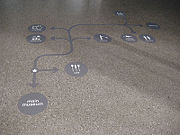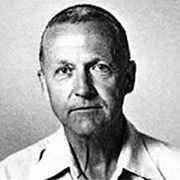Caitlin C Draft Two
From DigitalRhetoricCollaborative
(→Wayfinding) |
(→Wayfinding) |
||
| Line 3: | Line 3: | ||
Wayfinding is the use of certain cues to navigate a physical or digital space. It is a termed coined by Kevin Lynch to describe environmental legibility, elements of an environment that allow successful navigation through complex spaces. <ref> [http://webstyleguide.com/wsg3/4-interface-design/2-navigation.html Webstyle Guide to Navigation] </ref> Originally used as a technique for navigating physical environments, it has become applicable in navigation of digital environments and web design. | Wayfinding is the use of certain cues to navigate a physical or digital space. It is a termed coined by Kevin Lynch to describe environmental legibility, elements of an environment that allow successful navigation through complex spaces. <ref> [http://webstyleguide.com/wsg3/4-interface-design/2-navigation.html Webstyle Guide to Navigation] </ref> Originally used as a technique for navigating physical environments, it has become applicable in navigation of digital environments and web design. | ||
| - | [[Image:Wayfinding.jpg|thumb| | + | [[Image:Wayfinding.jpg|thumb|right|Finding Your Way]] |
__TOC__ | __TOC__ | ||
| Line 10: | Line 10: | ||
---- | ---- | ||
==History== | ==History== | ||
| + | |||
[[Image:Kevin_A_Lynch.jpg|thumb|left|Kevin A Lynch]] | [[Image:Kevin_A_Lynch.jpg|thumb|left|Kevin A Lynch]] | ||
| - | Wayfinding did not develop until the early 20th century. The term was coined by Kevin Lynch in <i>The Image of the City</i> in which he recognized the importance of an environmental image in wayfinding tasks.<ref>[http://idmaa.org/?post_type=journalarticle&p=1894 International Digital Media and Arts Association on Wayfinding]</ref> He divided the elements of a city into five distinct groups: paths (streets, bus lines, etc), edges (physical barriers such as walls or rivers), districts (places with distinct identities such as Wall Street or the Empire State Building), nodes (major intersections or meeting places), and landmarks (visible structure that can be used to assess orientation over long distances).<ref>[http://webstyleguide.com/wsg3/4-interface-design/2-navigation.html Webstyle Guide to Navigation] </ref> | + | Wayfinding did not develop until the early 20th century. The term was coined by Kevin Lynch in <i>The Image of the City</i> in which he recognized the importance of an environmental image in wayfinding tasks.<ref>[http://idmaa.org/?post_type=journalarticle&p=1894 International Digital Media and Arts Association on Wayfinding]</ref> He divided the elements of a city into five distinct groups: paths (streets, bus lines, etc), edges (physical barriers such as walls or rivers), districts (places with distinct identities such as Wall Street or the Empire State Building), nodes (major intersections or meeting places), and landmarks (visible structure that can be used to assess orientation over long distances).<ref>[http://webstyleguide.com/wsg3/4-interface-design/2-navigation.html Webstyle Guide to Navigation] </ref> Archietexts, urban planners, landscape architects, environmental graphic designers, and behavioral and cognitive psychologists have contributed to the study of wayfinding.<ref>[http://idmaa.org/?post_type=journalarticle&p=1894 International Digital Media and Arts Association on Wayfinding]</ref> |
| - | + | ||
==Modern Physical Usage== | ==Modern Physical Usage== | ||
| + | |||
| + | Today, the wayfinding technique is most commonly used in large buildings like hospitals and airports. Signs and architecture are intricately designed with the user in mind. Wayfinding airport designer Jim Harding asserts, "Ultimately, if we do our job well, wayfinding enhances the customer experience without them knowing why or how." <ref>[http://www.theatlantic.com/business/archive/2014/06/how-you-know-where-youre-going-when-youre-in-an-airport/372537/ The Atlantic: How You Know Where You're Going When You're in an Airport]</ref> Every aspect of design is considered from signage, lighting, and color to general architecture of the space. | ||
===Signage=== | ===Signage=== | ||
Revision as of 12:36, 15 April 2015
Wayfinding
Wayfinding is the use of certain cues to navigate a physical or digital space. It is a termed coined by Kevin Lynch to describe environmental legibility, elements of an environment that allow successful navigation through complex spaces. [1] Originally used as a technique for navigating physical environments, it has become applicable in navigation of digital environments and web design.
Contents |
History
Wayfinding did not develop until the early 20th century. The term was coined by Kevin Lynch in The Image of the City in which he recognized the importance of an environmental image in wayfinding tasks.[2] He divided the elements of a city into five distinct groups: paths (streets, bus lines, etc), edges (physical barriers such as walls or rivers), districts (places with distinct identities such as Wall Street or the Empire State Building), nodes (major intersections or meeting places), and landmarks (visible structure that can be used to assess orientation over long distances).[3] Archietexts, urban planners, landscape architects, environmental graphic designers, and behavioral and cognitive psychologists have contributed to the study of wayfinding.[4]
Modern Physical Usage
Today, the wayfinding technique is most commonly used in large buildings like hospitals and airports. Signs and architecture are intricately designed with the user in mind. Wayfinding airport designer Jim Harding asserts, "Ultimately, if we do our job well, wayfinding enhances the customer experience without them knowing why or how." [5] Every aspect of design is considered from signage, lighting, and color to general architecture of the space.


